Development and validation of an AMR-based predictive model for post-PCI upper gastrointestinal bleeding in NSTEMI patients
- PMID: 40309439
- PMCID: PMC12040647
- DOI: 10.3389/fendo.2025.1545462
Development and validation of an AMR-based predictive model for post-PCI upper gastrointestinal bleeding in NSTEMI patients
Abstract
Background: Upper gastrointestinal bleeding (UGIB) is a common complication in patients with non-ST-segment elevation myocardial infarction (NSTEMI) after percutaneous coronary intervention (PCI), and the aim of our study is to construct a nomogram for predicting the occurrence of UGIB within 1 year after PCI in NSTEMI patients.
Methods: In this study, 784 patients with NSTEMI after PCI in the Affiliated Hospital of Xuzhou Medical University between September 1, 2017 and August 31, 2019 were included as the training group, and 336 patients from the East Affiliated Hospital of Xuzhou Medical University were included as the external validation group. Classical regression methods were combined with a machine learning model to identify the independent risk factors. These factors based on multivariate logistic regression analysis were then utilized to develop a nomogram. The performance of the nomogram was evaluated using the area under the receiver operating characteristic curve (AUC), calibration plots, and decision curve analysis (DCA).
Results: The nomogram consisted of six independent predictors, including HASBLED, triglyceride glucose index, alcohol drinking, red blood cell count, use of proton pump inhibitor, and angiographic microvascular resistance of culprit vessel. Training and validation groups accurately predicted the occurrence of UGIB (AUC, 0.936 and 0.910). The calibration curves showed that the nomogram agreed with the actual observations and the DCA also demonstrated that the nomogram was applicable in the clinic.
Conclusion: We developed a simple and effective nomogram for predicting the occurrence of UGIB within 1 year in NSTEMI patients after PCI based on angiographic microvascular resistance.
Keywords: angiographic microvascular resistance of culprit vessel; nomogram; non-ST-segment elevation myocardial infarction; percutaneous coronary intervention; upper gastrointestinal bleeding.
Copyright © 2025 Wang, Yang, Zhou, Li, Chen, Chen, Li, Li and Xu.
Conflict of interest statement
The authors declare that the research was conducted in the absence of any commercial or financial relationships that could be construed as a potential conflict of interest.
Figures
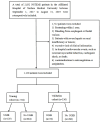
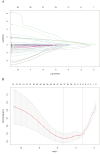

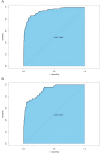
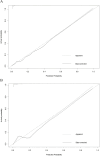
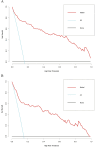
Similar articles
-
Development and validation of a predictive model for adverse left ventricular remodeling in NSTEMI patients after primary percutaneous coronary intervention.BMC Cardiovasc Disord. 2022 Aug 27;22(1):386. doi: 10.1186/s12872-022-02831-2. BMC Cardiovasc Disord. 2022. PMID: 36030211 Free PMC article.
-
Development and validation of a machine learning-based readmission risk prediction model for non-ST elevation myocardial infarction patients after percutaneous coronary intervention.Sci Rep. 2024 Jun 11;14(1):13393. doi: 10.1038/s41598-024-64048-x. Sci Rep. 2024. PMID: 38862634 Free PMC article.
-
Prognostic Nutritional Index Combined with Triglyceride-Glucose Index to Contrast a Nomogram for Predicting Contrast-Induced Kidney Injury in Type 2 Diabetes Mellitus Patients with Acute Coronary Syndrome After Percutaneous Coronary Intervention.Clin Interv Aging. 2023 Oct 3;18:1663-1673. doi: 10.2147/CIA.S429957. eCollection 2023. Clin Interv Aging. 2023. PMID: 37810953 Free PMC article.
-
Establishment and validation of a risk model for prediction of in-hospital mortality in patients with acute ST-elevation myocardial infarction after primary PCI.BMC Cardiovasc Disord. 2020 Dec 9;20(1):513. doi: 10.1186/s12872-020-01804-7. BMC Cardiovasc Disord. 2020. PMID: 33297955 Free PMC article.
-
A nomogram model for predicting intramyocardial hemorrhage post-PCI based on SYNTAX score and clinical features.BMC Cardiovasc Disord. 2024 Mar 25;24(1):179. doi: 10.1186/s12872-024-03847-6. BMC Cardiovasc Disord. 2024. PMID: 38528469 Free PMC article. Clinical Trial.
References
-
- Balzi D, Di Bari M, Barchielli A, Ballo P, Carrabba N, Cordisco A, et al. . Should we improve the management of NSTEMI? Results from the population-based “acute myocardial infarction in Florence 2” (AMI-Florence 2) registry. Intern Emerg Med. (2013) 8:725–33. doi: 10.1007/s11739-012-0817-6 - DOI - PubMed
Publication types
MeSH terms
LinkOut - more resources
Full Text Sources
Medical
Miscellaneous

